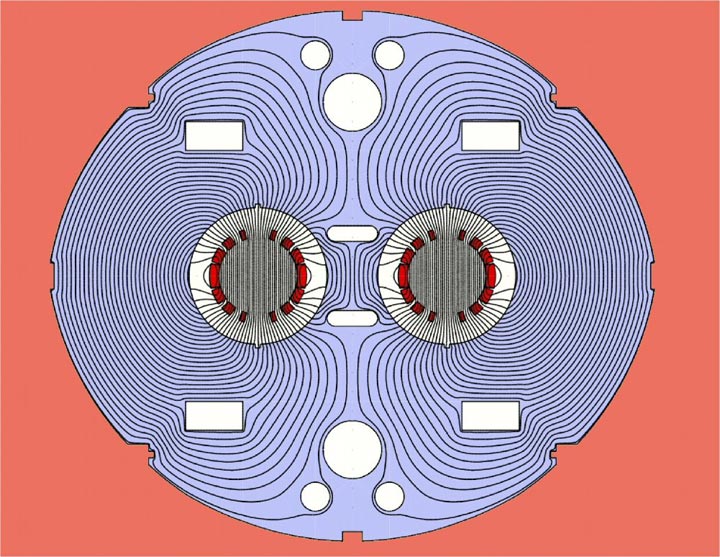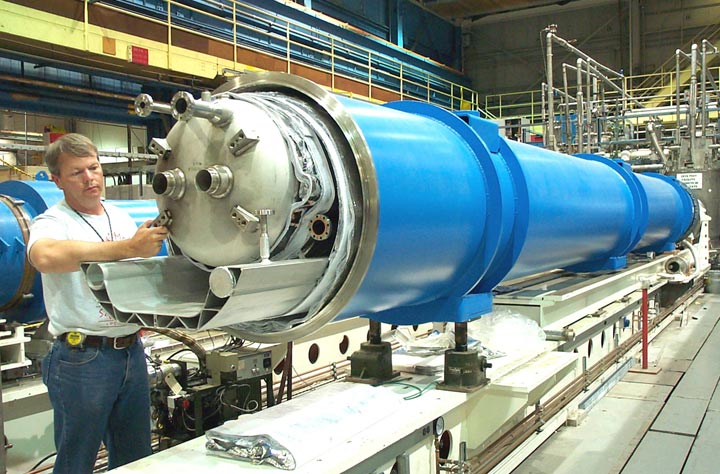LHC Dipole Magnet Program
The Superconducting Magnet Division built 20 superconducting dipole magnets for the Large Hadron Collider (LHC), which is now operating at CERN in Geneva, Switzerland. This machine will collide beams of protons with the unprecedented energy of 6.5 TeV per beam to explore the nature of matter at its most basic level. (RHIC can collide beams of protons with energies of 0.25 TeV, but is mostly used to collide heavy ions with energies of 0.1 TeV per nucleon). The magnets were built as part of the US-LHC program, recommended by the High Energy Physics Advisory Panel (HEPAP) and approved by Congress, to contribute to the construction and, later, use of that frontier machine by the US high energy physics community. Fermi National Accelerator Laboratory (FNAL) and Lawrence National Laboratory are also participants in this program, which has its headquarters at FNAL. The US supplied certain of the lattice magnets and other equipment for the LHC's Intersection Regions.
Having developed the main ring dipole magnets for the Superconducting Super Collider in the 1980's and early 1990's as well as all the superconducting magnets for RHIC, the Magnet Division was ideally suited to develop some of the dipole magnets for the LHC. Brookhaven's task was to provide the magnets that bring the LHC beams into collision at four interaction points, and to also provide magnets that will separate the beams at one point where space is needed for accelerating cavities.

Drawing of the magnetic flux in a dual aperture dipole magnet built at BNL for the LHC in CERN. The field is 3.8 teslas and has the same polarity in each aperture.
The magnets, 20 in all, are large: the largest have two, 10 meter long beam pipes with 80 millimeter apertures in a single iron yoke and weigh some 25 tons. The coils for all the magnets built by Brookhaven are the same as those used for the main RHIC bending magnets, but the yokes and containment vessels are new. The magnets have been designed and engineered at Brookhaven, and were assembled here with components made by Central Shops and purchased from outside vendors. Cryogenic testing at BNL showed that the magnets functioned well. Shipping these massive objects required the engineering and construction of special fixtures that ensured a safe arrival at CERN. The first of the magnets was shipped in 2004; the last, in 2006.
The talents and skills of many individuals are needed to successfully build superconducting magnets, with their large forces, high stored energy, cryogenic environment, and demanding precision. The necessary expertise was available at Brookhaven, a legacy of the ongoing program in superconducting magnets dating back to the 1960's. The magnet program for the LHC was one of many in which Brookhaven participates to provide magnets for far-ranging scientific programs, both in the US and abroad. Wherever possible, Brookhaven enlists industry to build components and production quantities of magnets, and has pioneered the outsourcing of superconducting magnet construction in this country. Most of the magnets for RHIC were purchased in industry based on designs developed at Brookhaven. The LHC magnets are being built at Brookhaven because of the many design variations required, making industrial assembly economically unattractive.

Photograph of a dual aperture magnet for the LHC being prepared for cryogenic testing.
For more information contact Michael Anerella.


